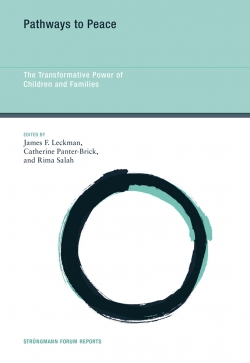Linking Peacebuilding & Child Development: A Basic Framework
Linking Peacebuilding & Child Development: A Basic Framework
Introduction
There is clear evidence that parents have an impact on children’s understanding of wars. The development of peaceful agendas in violent settings are vital to combat the perpetuation of violence across generations. Creating environments that are supportive, secure, and stimulating in the home and early childhood settings have huge impact on healthy brain development, learning, and development of cognitive abilities. What are the most influential factors that influence children to choose nonviolent behaviors and embrace peaceful conflict resolution? Are peaceful behaviors innate and biologically motivated, or are they learned behaviors?
Peacebuilding Framework
Peacebuilding is defined in this piece as any form of intervention that is carried out in response to a perceived conflict situation. This includes activities aimed at prevention of conflict, settlement, management of violent and crisis situations, processes aimed at reconciliation after the signing of an agreement or post-conflict reality. Early childhood development and education programs should accept conflicts as part of life and promote collaboration instead of competition in early childhood settings.
Promoting Peace Education in Early Years
There are a variety of skills associated with peace education including communication, listening, perspective taking, cooperation, problem solving, critical thinking, decision making, conflict resolution, and social responsibility. Introduction of peace education curricula and materials offer one way to counteract violent conflicts and destructive behavioral patterns in young children. In the US, there are many examples of both formal and informal peace education curricula. One example being peace education developed by United States Institute for Peace and Anti-Bias International and Arigatou International’s Program on ethics education for children. Such programs, however, are not all available in conflict or post-conflict settings and are sometimes hard to implement due to politics sometimes. When politicians hesitate to transform their educational systems to reflect the new reality that emerges from a peace process, children in schools and pre-schools will continue to grow up with old perceptions and habits of the conflict.
Theories of Conflict Resolution
The Basic Human Needs theory involves the idea of when a conflict emerges, individuals and groups are deprived of their basic needs; to resolve conflict, provide venues and alternatives to satisfy these unmet needs. This theory, however, is not widely tested and is strongly critiqued for the idea that basic needs are the same for all people. Conflict due to communication and perception problems revolves around the idea that misperceptions are created as a result of conflict socialization processes and dynamics which perpetuate animosity, hatred, fear of others. Conflict resolution often uses dialog and other communication techniques to correct negative image of the others, such as dehumanizing, stereotyping, or the belief in use of violence. In the tactic of interest-based negotiating, conflict is the product of perceived incompatible interests and while focusing on such interests as opposed to positions, conflicting parties will find common ground to build agreement. Emotions block cooperative negotiation processes and it is evident they need to be controlled.
Conflict Resolution Research
Biological deficiencies and hormonal imbalances have been identified as factors in explaining aggression, particularly in sexual offenses, but there is no well-researched link between individual acts of aggression and macro-level small group or even interstate conflict.
Conclusions
It is clear that the research link between biology and neuroscience development, early childhood development, as well as peace education need to be further researched and defined. Identifying the root causes of violence and addressing them directly is also to be applied, as constantly addressing one conflict after another individually requires longer-term investments in peace education in all our systems: legal, social, political, economic and educational. Transforming the global culture of violence can only be accomplished when children are enabled to learn and practice values and skills inherent to peace education, starting in the earliest developmental phase.
JOIN THE CONVERSATION
For breaking news and to stay connected, follow us on social media. Sign up to get our E-News delivered straight to your inbox.

